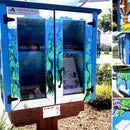Introduction: Back to the Future Miniature Cap
This instructable will show you how to make a tiny version of Marty's iconic tie dye baseball cap. You can also use these instructions to make any cap in miniature and use it as a charm, pendant or make a set for earrings.
Also, I usually edit out all my fails, but since there's an epic fail contest, what the heck. I'll show you my whole process, warts and all.
Step 1: What You Need
Sculpey clay - white
Clay tools - cutter (xacto), needle, smoother
Baking tray
Acrylic paints - yellow, blue, magenta
Water-based varnish (embossing enamel, acrylic polish)
Eye pin & jump ring
Step 2: Cap Top
Roll a ball of clay about 25mm. Cut the ball in half (this will make 2 hats).
Step 3: Brim
Flatten another piece of clay so that it's about 3mm thick and 20-25mm wide. This can be any length. If you roll it too wide, just trim it to size. Then cut out a moon shape. You can do this freehand or use a small round object as a template. A coin works well.
Step 4: Basic Cap
Take the little brim and attach it to the front of the cap. Use tools or your fingers to smooth the seams. Then gently shape the cap and brim to be symmetric.
Step 5: Seams
Use a straight edge and make score marks over the top of the cap. They should cross in the middle of the top as shown.
Step 6: Fabric
Make the cap a little puckered by gently pressing dents in between the seams. If you press too hard, just smooth out the area.
Step 7: Stitching
With a needle or needle tool press tiny rows of dots on each side of every seam. This goes faster than you think because the caps are small. Then make one stitching row where the cap meets the brim.
Reshape anything that needs it and you've got a tiny realistic cap!
Step 8: Eyepins
If your eye pins are longer than the cap, cut them to size. Then poke them into the clay so that the "eye" is horizontal to the hat base.
Step 9: Ready to Bake!
Bake according to the directions for the clay you are using.
(Everything went great up to here:)
Step 10: Where I Always Mess Up : (
Well, I burned my hats. I pretty much always burn my clay. This time I used my well-calibrated digital oven and a kitchen timer and I still burned them. But I'll be coloring over the clay, so hopefully it won't matter much.
Step 11: Problem #2
My original plan was to use my liquid Sculpey and add color to make the tie dye (if you do this, let me know how it went!), but my liquid Sculpey was not a liquid anymore. I tried to soften it in the microwave, which did work somewhat, but not enough to paint with.
Step 12: Problem #3
So, I got out my alcohol inks. I figured the colors would bleed together and drip just like tie dye, but all I got was a big reddish mess and colorful fingers. My cute hats looked like a medical procedure. Fortunately, I have alcohol ink thinner and was able to remove a lot of the worst spots.
After: This actually left the caps very dark which made the painting a lot harder. I had to cover the color without filling in all the details. This would have been okay on a larger project, but was really difficult on this scale.
Step 13: Acrylic Paint
I made a little tie dye puddle of paint by squeezing out a few drops of each color and mixing just a little with a toothpick. Then I dipped my finger in the paint and dabbed it onto the cap. I also tried dipping directly into the paint, but the caps were too small for this to work well. It did work on my larger test piece, though.
Step 14: Keep Painting
I had to let the paint dry and go over the ugly spots. This probably would have been much easier if my clay was nice and white. Like it should have been before painting. I wanted everything to be lighter, but I'll know for next time to start with the acrylics.
(I included my test pieces in the photo)
Step 15: Ready to Varnish
When the paint is 100% dry - I to waited overnight because my paint was really wet - it's time to varnish. You can use whatever you like best or have around. Options include acrylic varnish, acrylic floor polish and clear embossing enamel.
Step 16: Embossing Enamel
I thought it was too thick for this project. Also, the heat softens the clay, so be careful until it cools fully.
Step 17: Nail Polish
Shiny, but I can still see the detail.
Now, just add a jump ring and you can attach Marty's cap to a cord, keychain or ear wires.
I hope you enjoyed seeing the whole process of getting to the final tutorial. It's not always pretty!

Runner Up in the
Back to the Future Contest

Participated in the
Halloween Props Contest 2015













